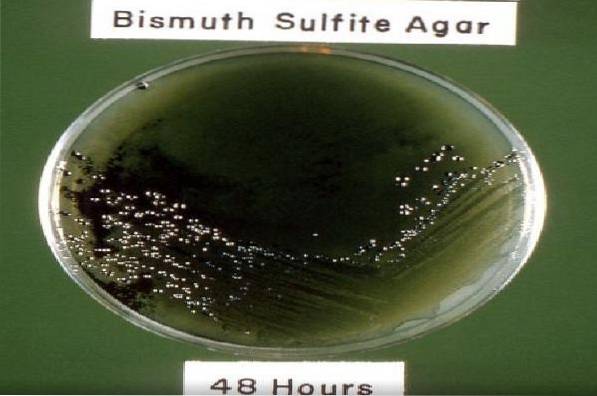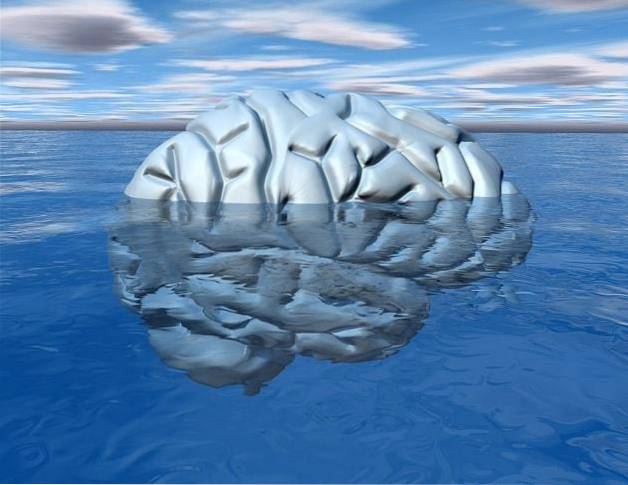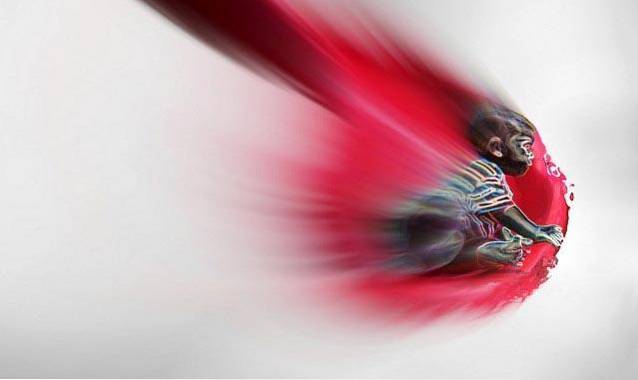
Bismuth Sulfite Agar Rationale, Preparation and Uses
The bismuth sulfite agar is a solid, selective and differential culture medium, specially formulated for the isolation of Salmonella enterica subgroup enterica serotype Typhi, among other species of Salmonella. The medium is known as BSA agar for its acronym in English Bismuth Sulfite Agar..
The original formula for bismuth sulfite agar was created in 1927 by Wilson and Blair (Glucose Bismuth Sulphite Iron Medium); It contained sodium sulfite, glucose, bismuth solution, ammonium citrate, ferrous sulfate, and agar-agar..

Today there is a modification of the original medium, composed of meat extract, meat and casein peptones, bismuth sulfite indicator, glucose, disodium phosphate, ferrous sulfate, bright green and agar-agar..
There are many means for the isolation of Salmonella species, but when it comes to recovering the Typhi serotype, bismuth sulfite agar has a notable advantage over them, since in most a very low or no recovery of this microorganism is obtained..
However, it is necessary to use more than one type of medium when trying to isolate enteropathogens, because bismuth sulfite agar is less effective for other Salmonella species and for the Shigella genus, which are inhibited or develop very poorly. in this agar.
It should be noted that of all Salmonella species, the Typhi serotype is one of the most important enteropathogens in humans, this being its only reservoir. This serovar causes typhoid fever, gastroenteritis, bacteremia, and septicemia..
For this reason, it is relevant to include this agar when analyzing water, feces or food samples where its presence is suspected..
Article index
- 1 Rationale
- 2 Preparation
- 3 Uses
- 4 Characteristics of the colonies on bismuth sulfite agar
- 5 Limitation
- 6 Quality control
- 7 References
Basis
Like most culture media, Bismuth Sulfite Agar contains nutrients to promote bacterial growth, such as peptones and meat extract. Likewise, glucose works as a source of energy and carbon..
However, not all bacteria will grow on this medium, as Bismuth Sulfite Agar is a selective medium. It contains compounds that inhibit the growth of Gram positive microorganisms and certain Gram negative bacteria. These compounds are: the indicator bismuth sulfite and bright green.
For its part, disodium phosphate maintains the osmolarity and pH of the medium.
Additionally, bismuth sulfite agar is a differential medium thanks to the presence of ferrous sulfate, which shows the formation of HtwoS. The HtwoS formed by bacteria reacts with ferrous sulfate and forms a clearly visible insoluble black precipitate.
Finally, the agar-agar provides the solid consistency to the medium..
Preparation
Weigh out 52.3 g of the dehydrated medium and dissolve in one liter of water. Heat the mixture to boil for 1 minute with frequent stirring, until completely dissolved. Do not overheat too much. This medium is not autoclavable as extreme heat damages the culture medium..
Allow to cool to 45 ° C and shake before serving in sterile Petri dishes. It is recommended to make plates with good thickness. For this, 25 ml must be poured into each plate. Let solidify. As it is a medium that is not sterilized, it is normal for its immediate use to be suggested..
However, a study carried out by D'aoust in 1977, showed that there is a better recovery of Salmonella typhimurium Y Salmonella enteritidis as Bismuth Sulfite Agar Medium ages, performance for serovars is not affected Typhi Y Paratyphi B.
D'aoust recommends using the plates on day 4 of refrigeration, although he warns that as the medium ages the selectivity decreases, developing more easily strains of Proteus vulgaris.
For this reason, for highly contaminated samples, such as feces, it is preferable to use the freshly prepared medium. Otherwise use on day 4 of its preparation. Other authors recommend using the plates the day after their preparation, stored in refrigeration..
Chilled plates must be tempered before use. The pH of the medium should be 7.5 ± 0.2. The color of the raw medium is beige and the prepared medium is greenish-gray opalescent.
Applications
Among the samples that can be planted in this medium are samples of feces, drinking water or wastewater and food..
To improve the isolates it is recommended to carry out a pre-enrichment treatment with lactose broth and after enrichment with tetrathionate broth or cystine selenite broth, before sowing on bismuth sulfite agar.
The plates are incubated at 35 ° C ± 0.2 for 24 to 48 hours, in aerobiosis.
Characteristics of the colonies on bismuth sulfite agar
The colonies of Salmonella Typhi they are usually seen on this agar within 24 hours with a black center and surrounded by a bright green halo. Whereas, in 48 hours they turn completely black due to the formation of hydrogen sulfide.
Salmonella Paratyphi A it presents colonies with variable characteristics. After 18 hours of incubation, black, green or transparent colonies with a mucoid appearance can be observed. While, at 48 hours, they are completely black and sometimes with a pronounced metallic shine..
S. Paratyphi A tends to blacken the environment around the colony.
Salmonella sp show black or greenish-gray colonies, with or without metallic luster, and may or may not blacken the surrounding environment.
Coliform strains are generally totally inhibited, but if they do grow, they develop as opaque green or brown colonies with no metallic luster. Do not stain the medium around the colony.
Limitation
-Very weak inoculums can cause colonies of Salmonella Typhi light green in color, going unnoticed and the culture being reported as negative.
- Bismuth Sulfite Agar may inhibit the recovery of some Salmonella species such as S. sendai, S. berta, S. gallinarum, S. abortus-equi.
-This medium inhibits most species of the genus Shigella.
- S. Typhi and S. arizonae can give very similar colonies.
-Coliforms that produce HtwoS such as Proteus and Citrobacter produce colonies similar to those of Salmonella, therefore it is necessary to perform biochemical identification tests.
-Good streaking must be done to obtain isolated colonies; it is the only way to observe the typical characteristics of colonies of the genus Salmonella.
QA
For the sterility control, an uninoculated plate is incubated at 37 ° C, it is expected that there is no growth or color change..
For quality control, known strains such as:
Escherichia coli ATCC 25922, Salmonella enteritidis ATCC 13076, Salmonella Typhi ATCC 19430, Shigella flexneri ATCC 12022, Enterococcus faecalis ATCC 29212.
It is expected that Escherichia coli Y Shigella flexneri are partially inhibited by developing greenish-brown and brown colonies respectively. Whereas, both salmonellas must have an excellent development with black colonies with a metallic luster, and finally Enterococcus faecalis must be totally inhibited.
References
- Wilson, W., & E. M. McV. Blair. Use of a Glucose Bismuth Sulphite Iron Medium for the Isolation of B. typhosus and B. proteus. The Journal of Hygiene, 1927; 26(4), 374-391. Retrieved from .jstor.org
- D'aoust JY. Effect of storage conditions of the performance of bismuth sulfite agar. J Clin Microbiol. 1977; 5 (2): 122-124. Available in: ncbi.nlm.nih.gov
- IVD Laboratories. Bismuth-sulfite agar according to WILSON-BLAIR. 2009.Available at: BismuthSulfitagar_span_Jan_2009% 20 (2) .pdf
- Himedia Laboratories. Bismuth Sulphite Agar. 2017.Available at: himedialabs.com
- Forbes B, Sahm D, Weissfeld A. (2009). Bailey & Scott Microbiological Diagnosis. 12 ed. Editorial Panamericana S.A. Argentina.
- Morales R, de la Cruz D, Leyva G and Ybarra M. Bacteriological Quality of Raw Goat Milk Produced in Miravalles, Puebla. Rev Mex by Ing Quím 2012; 11 (1): 45-54



Yet No Comments